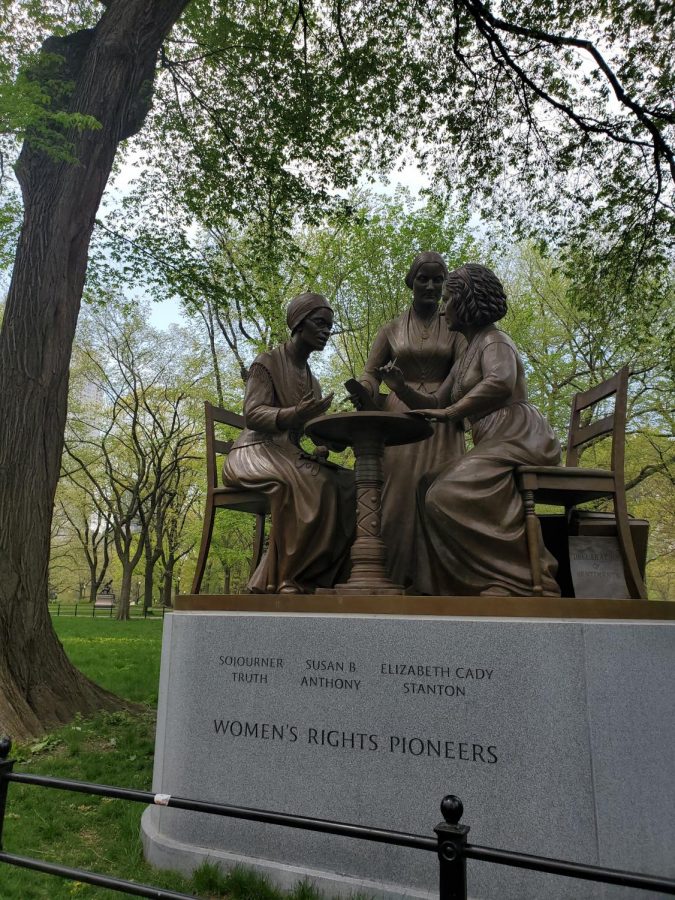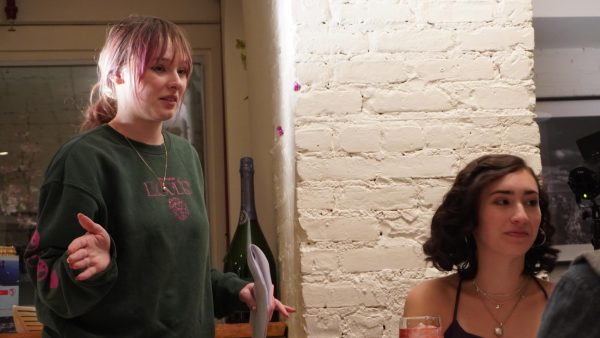A New Speaker’s Corner in Central Park
The Suffrage Academy Welcomes Coline Jenkins- The Great-Great-Granddaughter of Elizabeth Cady Stanton
Marymount Manhattan College’s semester-long Sojourner Truth Suffrage Academy ends on a high note with the welcoming of Coline Jenkins, the great-great-granddaughter of Elizabeth Cady Stanton. She spoke to the MMC community about Stanton as well as her own extensive work in the world of women’s equality. Jenkins opened up about her journey thus far with her work as co-founder of The Elizabeth Cady Stanton Trust, which serves to preserve women’s rights history, educate others about women’s rights history and promote women’s equality.
President Kerry Walk opened the Zoom event by introducing Jenkins and commenting on the extensive activism women have worked for throughout history in order to gain equal rights. Although women’s rights have come a long way from the days of the Seneca Falls Convention and Elizabeth Cady Stanton, there is still a lot of work to do regarding the disparities women face in their quotidian lives and routines.
Before passing the mic to Jenkins, Dr. Walk quoted Elizabeth Cady Stanton saying, “To refuse political equality is to rob the ostracized of all self-respect, of credit in the marketplace, of recompense in the world of work, of a voice in choosing those who make and administer the law, a choice in the jury before whom they are tried, and in the judge who decides their punishment.” Reflecting on the uphill battle women have faced gaining representation Dr. Walk said, “We have to fight for that self-respect and the dignity of all people.”
As Jenkins unmuted herself and allowed the audience to give her a round of applause and a series of clapping emojis, she stunned the entire call because of her devoted work to the women’s movement. Her zoom box lit up with her smiling face and a black and white cardboard cutout of her mother, adorned with a sash reading “Votes for Women.” Every aspect of this event was thrilling as the audience watched history unravel right before them. Jenkins brought out some relics from the women in her family, and she added some personal anecdotes to the photos she grew up surrounded by.
Everyone in the call leaned into the conversation as Jenkins shared anecdotes and objects of the Stantons to give a better sense of the journey for women’s equality. Jenkins shared a picture of Elizabeth Cady Stanton in her early adulthood who was pictured wearing a beautiful coral necklace. The coral necklace was a symbol of Stanton’s fight for gender equality. Jenkins reveals a story of how one day when Stanton was wearing the necklace, a law clerk asked her who owned the coral necklace, to which she responded with, “I own it, it’s my Christmas present.” The law clerk reminded her, “Well once you marry, your husband will own it.”
During those times, when a woman married, she became civilly dead in the eyes of the law. Stanton already saw this as a disgrace, but her last straw was listening to the annual reading of the Declaration of Independence in her town, and it planted seeds in her mind to demand women’s equality in regard to “all men are created equal.” Stanton truly was 50-to-100 years ahead of her time. Stanton and her husband attended the first World Anti-Slavery Conference, and she attended as a “delegate.” At that time, it was considered promiscuous for a woman to speak at a mixed-gendered meeting. Stanton had attended the anti-slavery conference, and Frederick Douglass had attended the first Women’s Rights Convention. Douglass was a fantastic orator in favor of women’s rights. They were both advocates for each other’s causes. During the first Women’s Rights Convention in Seneca Falls, NY, Sojourner Truth, the namesake of the Suffrage Academy program, stayed with Stanton at her house, forming a strong bond under their mutual views regarding women’s equality. In the end, it took 72 years for the US Constitution to change not only the women’s right to vote but all citizens’ right to vote. “America is an evolving nation,” said Jenkins and it seems to be evolving in some great directions.
At this point, Jenkin pulled out a copy of the Constitution and reflected on the 19th Amendment. Pointing to the Amendment giving women the right to exercise the right to vote, Jenkins said, “To me, this is a weapon… the right of citizens shall not be denied.” Kissing the document, Jenkins pointed out that nearly everyone who gathered for the zoom call would be considered invisible in society if not for this watershed movement for women’s voting rights.
Jenkins’ continuous work in the fight for women’s equality hasn’t slowed down one bit and her work continues to trek on. One of her trust’s biggest efforts was just completed last summer: A Sojourner Truth, Susan B. Anthony and Elizabeth Cady Stanton statue was placed in Central Park. All three women were very different in character, but each contributed and collaborated to a movement that would change society forever. Before last summer, all of the statues depicting women or girls in Central Park were exclusively fictional characters. The project started in 2013 and took seven years for it to finally be approved, but it was just in time for a special unveiling. The statue was unveiled on August 26th, 2020, the 100th anniversary of the 19th Amendment. “We made this statue for you, don’t just be a viewer, be a message leaver,” Jenkins said.
It is pivotal for women and girls to see themselves represented as real women in Central Park. Fictional characters such as: Mother Goose, Alice in Wonderland or Juliet Capulet, do not accurately represent women in the least. As a result of this monumental effort, people have been able to enjoy the statues and celebrate them alongside women’s rights victories today. Jenkins said, “This monument has taken on a life of its own.” When the late Justice Ruth Bader Ginsburg passed in September of 2020, people gathered collectively in Central Park to put up a “RIP RBG” banner on the monument. This monument does not just represent women of the past, but also represents and encourages women at this moment.
Towards the close of this event, Jenkins offered a few sentiments of advice. When it comes to activism, “You have to start with yourself,” she said. There are going to be moments when you “hit ceilings” and realize disparities in different areas of your life, but only realizing injustice or inequality is not enough to create change. “Take that energy and do something with it,” Jenkins said. It takes collective energy and resources to attain cognitive liberation, which is why it is important to speak up and speak out.
After offering a personal history of her great-great-grandmother and displaying the hard work and strenuous effort it takes to create change, Jenkins uplifted the audience with the courage to also take part in this work in their own ways.
“The ball is in your court now,” she exclaimed as everyone in the call waved goodbye and cheered for the next wave of women’s rights.

My name is Gabrielle Fiorella. I am a senior double majoring in Digital Journalism and Cinema, Television and Emerging Media with a minor in International...








Joel Stafford • May 5, 2021 at 12:43 am
Great article! I love to read what you have to say, Averee. You write with such volume and provide such an organic flow to the reader. I can’t wait for more content from you!